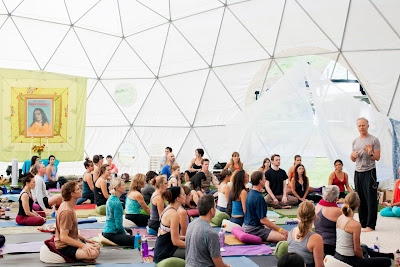 |
| Rod Stryker explaining the Pranayama breathing practice at Wanderlust California. Photo © Matthew Wakem |
Inhale. Exhale. We breathe 24 hours a day, and we rarely think much about it. But at Rod Stryker’s Pranayama class at Wanderlust California last weekend, students learned that there’s so much more to breathing than oxygen intake. In fact, your breathing pattern—rapid, uneven, audible, silent, shallow, deep, or all of the above—can tell you a lot about your physical and emotional well-being.
During the 1 hour and 30 minute class, Stryker gave festivalgoers a crash course pranavayus—the 10 expressions of prana in the body, or in simpler terms, the fundamental energizing force inside of us. Stryker focused on 5 vayus in particular, each of which has a physical and related emotional function:
Apana, located between the pubis and the pelvic floor, has the physical function of elimination and the emotional function of letting go (i.e. forgiveness).
Samana, located between the pubic bone and solar plexus, has the physical function of assimilation—converting substance into energy, and the emotional function of being able to derive wisdom from experience.
Pran, located between the solar plexus and the collar bone, governs vital physical functions like inhalation and heart rate as well as their more emotional counterparts—regeneration and revitalization (i.e. when you lack energy and motivation, your pran vayu is likely compromised).
Udana, located between the collar bones and the throat, rules the physical function of exhalation and the emotional function of psychological growth (i.e. your willingness to expand).
Diyana, which isn’t located in any one particular place, governs circulation and, on an emotional level, your ability to move freely from one vayu to another, which also signifies your ability to move freely through various areas of your life.
 |
| Rod Stryker teaching students about the vayus. Photo © Matthew Wakem |
After explaining the vayus, Stryker asked students put them into action by mindfully and evenly breathing through each, starting from the pelvic floor (apana). The lesson? Breathing through the vayus isn’t as simple as it seems. Most people, myself included, encountered some blocks, realized that they were unconsciously skipping a vayu or two, or had difficulty breathing into certain vayus no matter how hard they tried. Perhaps the most interesting part of all was that the vayus that people had trouble with were typically a reflection of their current emotional state. Apparently, I have some work to do.
 |
| Students take time to breathe through their vayus. Photo © Matthew Wakem |
For more information on Rod Stryker and his workshops, visit www.parayoga.com or buy his new book, The Four Desires: Creating a Life of Purpose, Happiness, Prosperity, and Freedom.
For a taste of the Wanderlust festival experience, go to Wanderlust at The Cosmopolitan in Las Vegas, from September 10 to 11.





0 comments:
Post a Comment